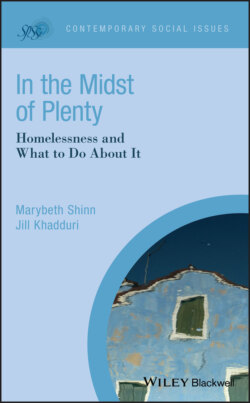Читать книгу In the Midst of Plenty - Marybeth Shinn - Страница 17
People with Chronic Patterns of Homelessness
ОглавлениеThe transitory nature of shelter use for many people and the extensive use of the shelter system by individuals who stay for long consecutive periods or come back often gave rise to the concept of “chronic” homelessness. HUD defines chronicity not only by the length of literal homelessness but also by the presence of a disability, on the grounds that people who meet both criteria will need housing with ongoing supports. To meet the definition, an individual must have been homeless for at least a year, either continuously or over at least four episodes in the past 3 years,11 and also have a diagnosable substance use disorder, serious mental illness, developmental disability, posttraumatic stress disorder, cognitive impairment resulting from a brain injury, or chronic physical illness or disability (U.S. Department of Housing and Urban Development, 2015a).
About a quarter (24%) of all individuals experiencing homelessness on a particular night in 2018 had chronic patterns, and almost two‐thirds of them (65%) were staying in unsheltered locations (Henry, Mahathey, et al., 2018). Many fewer families with children have chronic patterns of homelessness. Communities recently began to report that number, and only 5% of people in families would meet the HUD definition of chronic homelessness (Henry, Mahathey, et al., 2018, p. 3.3).
The definition of chronic homelessness focuses on people who are literally homeless –who make extensive use of the shelter system or often sleep in unsheltered locations, or both. For this group, the periods of time not literally homeless may still be remarkably unstable. As Shlay and Rossi (1992) put it, “the line between being homeless and being domiciled is a fuzzy boundary, often and easily crossed.” For example, more than half of a small sample of individuals with serious mental illnesses who entered a shelter in Westchester County had spent most of the past 5 years riding an institutional circuit of shelters, jails, detox facilities, psychiatric hospitals, rehabilitation facilities and the street, punctuated by stays in their own place or living doubled up with other households (Hopper, Jost, Hay, Welber, & Haugland, 1997).
